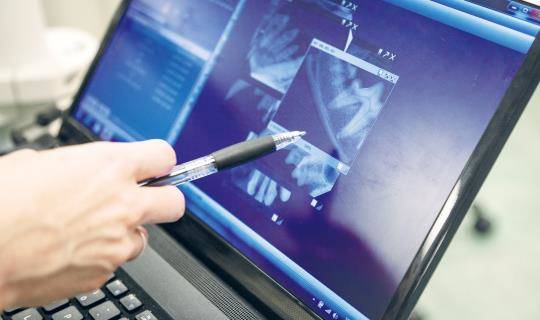Masterful Drill Work
By Randi Brannan, DVM, DAVDC

Remove a portion of the buccal cortical plate (alveolar bone) to help free the underlying root of its bony encasement. Since the alveolar bone is the strongest supporting structure of the periodontium, its partial removal is a significant means to weaken the body’s attachment to the root. Only the buccal cortical plate is removed in this approach, to maintain the structural integrity of the lingual and palatal alveolar bone.

Bone removal is best performed with a round or pear shaped carbide bur on a high-speed handpiece. Bone removal requires the precision and sharpness of the bur and the cooling provided by the spray of water from the handpiece to avoid burning and damage to the bone. Care should be taken to remove the buccal bone the entire width of the root without causing collateral damage to adjacent roots. More buccal bone can be removed if additional root exposure is needed to facilitate the extraction. Additional root exposure is particularly helpful to isolate fractured root tip fragments for easier removal.
The soft tissue flap that was initially created must be protected from the spinning bur to avoid damage to it. An instrument such as a periosteal elevator makes a good tissue retractor and tissue protector.

Care must be taken to avoid excessive gouging of the root itself. The bur can easily remove a significant amount of root structure in addition to the bone if the operator is not careful. This is especially important in the maxilla where the buccal cortical plate is thinner than in the mandible. Gouging the root will remove cementum and dentin. That will weaken the root and could lead to fracture of the root with the normal force of elevation.
All multirooted teeth should be sectioned into single root segments to facilitate an easier and predictable extraction. This means that a double rooted tooth such as a mandibular premolar should be sectioned through the furcation into two separate root segments, and a triple-rooted tooth such as a maxillary fourth premolar tooth should be sectioned through the furcations into three separate root segments. Tooth sectioning counteracts the divergent roots’ mechanical advantage and also enables access to the interradicular (between the roots) area for elevation.
A crosscut fissure bur on a high-speed handpiece makes the most effective sectioning tool. The furcation needs to be clearly identified. The cut is made starting from the furcation toward the crown. The cut through the crown must be complete. If the crown segments do not move independent of one another and are still joined, the extraction will be very difficult, and the risk of root fracture is increased. The crown may be shaped in any way that allows for easier removal of the root(s) with the crosscut bur after sectioning. Some find it helpful to remove part of the remaining crown to maneuver the elevator and to avoid excessive leverage on the crown.
There are many choices of burs. Carbide burs are sharp and cut deftly. They are recommended to remove buccal bone and to section the crowns of teeth. The #2 and #4 round burs are appropriate for buccal bone removal in the dog and cat. The #701L crosscut fissure bur is ideal to section the crowns of teeth in the dog and the #699 for the cat. The #330 pear bur can be used to remove buccal bone and to section the crowns of teeth in the cat. Once the teeth are removed and the sockets cleaned of debris, the remaining bone can be smoothed with a diamond bur over which the soft tissue flap is sutured in place.
While dental extractions can sometimes be time consuming and frustrating, with the correct tools, skills and the practical tips above, any trepidation you may be feeling should be relieved.






